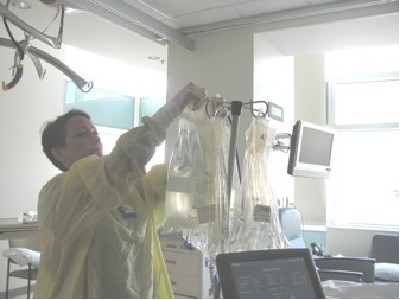Ergonomic Solutions Enhance Comfort, Safety

Old dialysis machine |
When nurses on Shapiro 6 struggled with an ergonomically challenging NXStage dialysis machine, Nancy Hickey, MS, RN, director of Nursing for Medical Services, turned to nurse educator Maria Bentain-Melanson, MSN, RN, CCRN, CSC, for help.
“To change the 11.5-pound bag of fluid, nurses had to lift the bag up above their shoulders and maneuver it onto the hooks,” she said. “It was very difficult.”
Bentain-Melanson and nurse manager Matt Quin, MSN, RN, worked with Tucker O’Day, MSPT, program manager for Ergonomics in Partners Occupational Health, to conduct focus groups on the unit and collect feedback from nurses using the dialysis machines. They reported that feedback to the vendor, requesting that the company redesign the machines.
The company did just that, lowering the bag height by about a foot and redesigning the hooks. The new machines arrived at BWH in February for nurses to trial.
“The hooks on the new machines make it easier to hang the bags,” O’Day said. “And, most importantly, now nurses don’t have to lift the bags over shoulder height and hold them there while trying to maneuver them onto hooks. This new design will make it much less strenuous to change the bags of fluid.”
This initiative is among several underway to ergonomically enhance nursing work environments at BWH.

New dialysis machine |
In the Dialysis Unit, nurses experienced problems towing heavy equipment to inpatient units. Last year, O’Day worked with BWH Occupational Health, nursing leadership and staff nurses to solve this problem, helping to arrange for the equipment to be mounted on a motorized cart so that nurses could transport the equipment and supplies to the bedside more easily.
“The project with Dialysis went very smoothly and was a perfect example of how we hope projects will proceed,” O’Day said. “Nurses informed us of their issue with towing heavy equipment, and with administrative support, we all worked together to come up with a solution.”
Another broad reaching and significant ergonomics initiative that has been strongly supported by hospital administration involves the installation of ceiling lifts to prevent nursing injuries related to patient handling. To date, 409 ceiling lifts have been installed throughout the hospital. “The lifts help protect nurses, and they’re also more comfortable for patients than being lifted manually,” O’Day said. “What is concerning, however, is that some nurses are choosing not to use the lifts.”
To help with this, two pilot programs are being implemented. A‘Safe Work Clinician Pilot Program’ will help return injured nurses to work following their injury. When a nurse becomes injured after lifting a patient manually on a unit where ceiling lifts have been installed, he or she will receive job coaching from another nurse to increase their comfort level using the ceiling lifts and to help them understand the importance of protecting themselves from re-injury. In April, a train-the-trainer pilot in safe patient handling and ergonomics kicks off in the MICU. “
This pilot will focus on training unit champions on each shift to use the ceiling lifts properly, set up eMAR workstations so they are ergonomically correct, and identify potential risk factors that could contribute to musculoskeletal injury,” O’Day said.
O’Day and Jenny deSa, OT/R, MS, Ergonomics Specialist, continue to conduct ergonomic assessments of departments and nursing stations, individual workstations and equipment. Anyone interested can request an assessment of their area by contacting O’Day at eechlinoday@partners.org or via the “PHS Ergonomic Request” mailbox on Outlook.